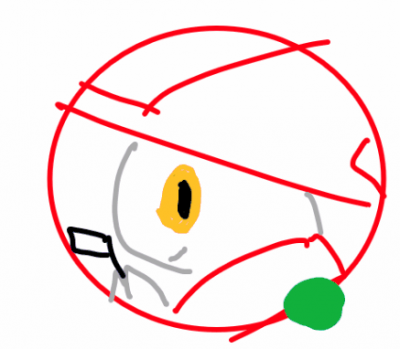For those unaware, Velocity Clipping is a glitch that allows Kirby to be launched out of a loop at an extremely high speed (say ~10 times faster than normal). In particular, this can be used to clip through walls. It was first properly documented in June 2016 by GloriousLiar (though I did briefly see it in February of that year :|) and is extensively used in his TAS of the game, finishing the game in about 25 minutes, over twice as fast as the RTA World Record.
There were two problems preventing this glitch from being RTA viable. Firstly, there was the obvious precision involved, though this could be mitigated with a proper setup. Secondly, and perhaps more damning, was the requirement of us to generate a long enough line segment. In order to actually generate this segment properly, pause buffering would absolutely be needed. Naturally, it would be cumbersome to use the in-game pausing due to how brief it is between pausing and unpausing making it difficult for us to get a feel for generating the segment. The 3DS Home Menu seemed like an option, but it actually does not fully pause the game when activated, thus ruining the ability to make such tight inputs.
We have theorized for a while that Velocity Clipping is possible to perform on the Wii U Virtual Console release thanks to having far better pause buffering in the Virtual Console menu. While I had little trouble in generating the segment, the setup itself proved to be difficult. Today, GloriousLiar proved that it indeed can be done RTA through a more refined setup.
So what exactly is getting changed up?
Rule Changes:
Any% has been divided into two subcategories: Glitchless and Glitched (I may rename Glitchless to No Major Glitches). We felt it was important to make a distinction between the two, since unlike the discovery of soft-resetting the Jump Game, which saved a large amount of time (over 150 seconds), there is a substantial amount of skill involved in using this glitch and it saves far more time (at LEAST 5 minutes, upwards of 10 depending on how far this gets taken). However, we are using a subcategory as opposed to separating them into more concrete categories due to the fact that the Glitched is only different through its occasional uses of Velocity Clipping: At least 80% of the run will remain identical to Glitchless, it has the same starting point and the same ending point, and there are no (important) differences in terms of collectibles. Not to mention that there doesn't seem to be enough interest in running the glitched route to separate it as its own category.
Glitchless will effectively be the same run people have been playing and refining over the past several years. It will ban intentional use of Velocity Clipping and any instance of launching Kirby. Conversely, the Glitched category will allow these. There are a few more minor glitches related to the Kracko fight and Paint Panic. Due to how minimal time they save (or waste!) and their debatability as to being a glitch, they will remain legal for Glitchless.
Preliminary Routing Information:
Unlike the TAS for this game, there is a noticeable amount of real time needed to buffer for the inputs that are required to generate the launch. Thus, the use of launching purely as a movement option is not at all feasible for an RTA speedrun (though it may be an option worth considering for an in-game time speedrun). Instead, we will use launching as a means to clip through parts of a level, which can save substantial amounts of time on each level. Here are some particular areas of interest for clipping (the timesaves given are estimates and assume you get the clip first try, and each attempt should take about 5-10 seconds):
"Easy":
- Toy Town 2: As seen in the video above, you can clip through the top wall at the start of the 2nd Screen, at which point you'll be able to access the exit straight away (saves ~30 seconds).
- Silent Seabed 1: There is wall separating the very start of the screen from the very end, so it's simply a matter of clipping through it (saves ~45 seconds)
Not as "easy" but very rewarding:
- Contrast Cave 2/3: You can clip through the floor towards the start of the screen, leading to a medal room. The door out of this medal room puts you at the end of Screen 3 (saves ~1 minute)
- Paletto Polis 2: You can bypass the whole gate puzzle by clipping through the gates right away. Note that it is possible to get stuck in between the gates, forcing a reset (saves ~75 seconds)
- Cold Course 1/3: Enter the medal room in Cold Course 1, then clip through the wall on the right that leads to the next medal. The door after that 2nd medal leads to the end of Cold Course 3 (saves over 2 minutes)
- Frozen Fantasy 3: The wall to the left of the start actually leads to the end of the stage. It can be difficult to clip through, but should we succeed, we can hit the color switch in that area, deactivate all the blocks surrounding the exit, and finish the stage from there (saves ~1 minute)
Some other places where we can try using it (off the top of my head):
- Tiny Town 3
- Mag Mount 2
- Silver Submarine
- Machine Mansion 2
- Dungeon Dome 1 and 3
- Canvas Canyon 3
- Collapse Castle
- Volatile Volcano 1
- Frozen Fantasy 1
- Mad Mechanism 3
- Spectacle Space 2
In addition to this, it is also possible to clip into a wall and then be ejected upwards out of the wall, or to guide Kirby through a large wall. GloriousLiar will have more details on this, but this also could be used in a variety of stages. For now, it's probably best to just focus on the clipping aspect, since this is another can of worms entirely.
Reposting from my TAS submission from December 2016:
Glitch, Trick, and Game Mechanic Explanations:
Looped State: Kirby can be in what is called a looped state, which can either be defined as just coming out of a loop or riding a new line after looping previously in the level. This is cancelled when kirby hits a floor and seems to lose some momentum/stars fly out from collision with the floor.
Line Attachment: Kirby can be attached to a line, which is to say not matter the orientation of the line, Kirby will ride it until the end or until the line fades away.
Line Composition: A line is composed of multiple line segments, ranging from 6 to 47 pixels in length. A line must have at least 2 segments to persist. The segments can be of varying lengths, which is important for some later tricks.
Position Correction Displacement The previous explanations weren't glitches or tricks but are necessary to explain this next concept. If Kirby is in a looped state, and is attached to a line, encountering a new line at a pixel-perfect location on the original line creates an unknown attachment state. This encounter makes it difficult to determine which line Kirby should then be attached to, the original or new line. As a fail-safe mechanism, the developers made it so that when this undetermined state is reached, Kirby should be placed at the beginning of the previous line segment (not the whole line), and try the movement again. As long as both lines persist, Kirby will run into the new line, teleport backwards, run into the new line, and the process repeats itself until one of them disappears.
Position Correction Launch The first unintended consequence of the position correction displacement mechanic is getting a launch out of Kirby's displacement. This is a major speed increase; where Kirby's speed is normally capped at 4 units per frame, these launches can yield speeds of up to 47 units per frame. This is performed by setting up the position correction displacement and then forcing the line beneath Kirby to disappear. The result is that Kirby will launch backwards, starting at the speed equal to the length of the last segment. It is important to make the last line segment as long as possible to get the most speed. There is a simple method to get a launch in nearly any direction or speed. Put Kirby through a loop to set up the looped state. Draw the first segment of the new line Kirby will launch from. Kirby won't attach to this line until at least 2 segments are drawn. You don't want Kirby launching from the line with the loop because it will take longer for it to disappear than the new line. It is also important to make this segment short, because it will disappear faster. When Kirby reaches the position of the first segment, draw the second segment in the direction desired and of the length needed. This completes the line Kirby will launch from. It is also important to note that the line is drawn opposite the direction Kirby will launch, because Kirby gets displaced backwards. Draw a new arbitrary line segment. This does nothing other than to make the line Kirby will launch from disappear. Draw a new line for Kirby to collide with at the end of the long segment. This position is pixel perfect for a specific speed, but there are multiple locations which give different speeds. The positions of these locations are all parallel to the line. At this point the line disappears, and Kirby will be displaced backwards and maintain the "speed".
To better illustrate this process, I made a short gif: http://imgur.com/hNpXfqd
Velocity Clipping: Launching is great, and lets you traverse large areas quickly, but more can be done with this speed. If Kirby is moving fast enough toward an obstacle such that on one frame he would be inbounds and the next would be somewhere within the obstacle, Kirby will actually ignore hit detection on the wall and move inside the obstacle. See more on the use of clipping in out-of-bounds movement.
Position Correction Displacement Clipping There is a more direct form of clipping out-of-bounds that is used situationally. The same setup as normal Position Correction Displacement is performed, but the line used to teleport starts inside the wall. When Kirby gets displaced backwards, he will actually be inside the wall. This method allows for some neat sequence breaks. Because water will not let Kirby launch at high speeds, this is the only way in which out-of-bounds clipping can be achieved from within water. Ink Conservation There is a finite amount of ink available for use. Ink can be refilled, but in general it is slower than just working with the ink available. It runs out very quickly while setting up a lot of the glitches, so there are methods used to conserve ink and get by with very little. One small tick on the ink meter is all you need to draw a line (2 segments). This can only be done though if the first segment is as short as possible. If you have any ink whatsoever, you can draw a line segment the maximum length (47 units). So even with the minimum amount of ink, you can draw a decently sized line that works for most purposes. This is used a lot while out-of-bounds, because there is no way to refill ink and it is critical to always be able to draw sufficient lines.
Out-of-bounds Movement Being out-of-bounds, more specifically inside obstacles, has very weird properties. When inside an obstacle, the game forces you violently upward, usually to the tune of 30 units per frame. This quickly gets out of hand and Kirby must be manipulated with lines to not lose control and die from straying too far out of the bounds of the level. As a result gaining height while out of bounds is very quick, and Kirby can traverse long vertical sections quickly by riding walls in certain situations. Horizontal movement is trickier, because Kirby must be touching a line at all times. To make this quick is an ink-heavy process, and properties of lines described earlier must be abused to conserve ink. You cannot loop out-of-bounds so it is a slow process, but the amount of the levels that can be skipped as a result is tremendous. Lastly, one more type of out-of-bounds movement exists, and that is downward vertical movement. Kirby gets forced violently upwards, so it is not obvious how to move Kirby downwards while out-of-bounds. The only known way to accomplish this is by rubbing against the edge of the level (where the camera locks, it's not a standard wall) and drawing straight vertical lines from below. This sucks Kirby downwards in the direction of the lines.
 As far as a setup for RTA goes, this is what is required:
-Make a loop, open the VC menu
-Buffer an input at maximal segment distance (a couple of kirby-widths away, needs to be practiced) and about 15 degrees downward, close the VC Menu and open it again.
-Close and open the VC menu with no input, buffering another frame so you stop drawing the line
-Close the VC menu buffering an input directly above the end of your last line and keep it held.
-If successful, your line will be drawn horizontally with the movement of the camera and kirby will hit your second line and lurch backwards. You will either fall off the line or be launched backwards.
As far as a setup for RTA goes, this is what is required:
-Make a loop, open the VC menu
-Buffer an input at maximal segment distance (a couple of kirby-widths away, needs to be practiced) and about 15 degrees downward, close the VC Menu and open it again.
-Close and open the VC menu with no input, buffering another frame so you stop drawing the line
-Close the VC menu buffering an input directly above the end of your last line and keep it held.
-If successful, your line will be drawn horizontally with the movement of the camera and kirby will hit your second line and lurch backwards. You will either fall off the line or be launched backwards.






